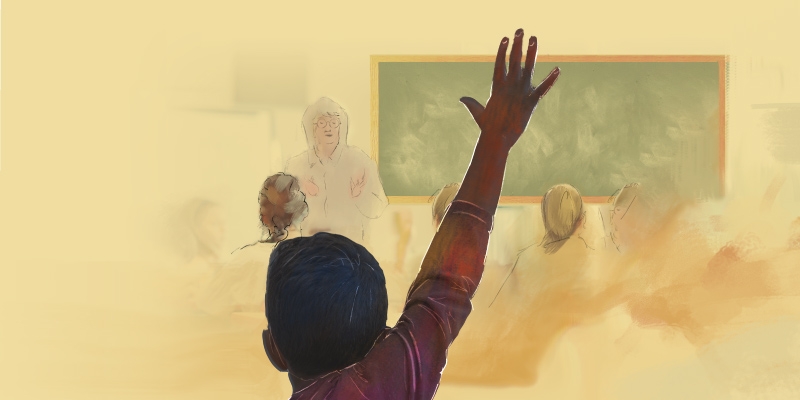Where Our Students Are Educated: Measuring Student Enrolment in Canada, 2022

This study measures the degree to which Canadians in each province choose between the three principal ways of educating their children: public schools, independent schools, and homeschooling. The study covers the period from 2000–01 to 2019–20.
It is important to understand the enrolment numbers within the context of a declining school-aged population, which obviously has an impact on school enrolment. The number of Canadians aged 5 to 17 declined 0.2 percent between 2000 and 2020. Every province except Alberta (growth of 24.1 percent) recorded a decline in their school-aged population over this period.
This study is an update to and based on several previous editions, specifically MacLeod and Hasan (2017); Van Pelt, Clemens, Brown, and Palacios (2015); and the original, Clemens, Palacios, Loyer, and Fathers (2014).
Public Schooling
As detailed in the full report, education in public schools is the dominant form of education in all ten provinces. Education in public schools can take a variety of forms depending on the province, including Anglophone public, Francophone public, Anglophone separate (largely Roman Catholic education), Francophone separate (again largely Roman Catholic), and charter schools. In 2019–20, Newfoundland & Labrador had the highest level of enrolment in public schools at 98.2 percent of total enrolment; British Columbia had the lowest level at 86.4 percent.
Every province except Alberta (increase of 24.7 percent) recorded a decline in the absolute number of students enrolled in public schools.
Newfoundland & Labrador recorded the largest decline in public school enrolment over the period (29.4 percent). It also, however, experienced the largest decline (28.3 percent) in the school-aged population of any province.
Every province, including Alberta, also experienced a decline in the share of total students receiving their education from public schools. Every province provides both majority language instruction (French in Quebec, English in all other provinces) as well as official minority language instruction (English in Quebec, French in all other provinces) within its public-school systems.
The highest rate of Anglophone public school enrolment in 2019–20 was in Newfoundland & Labrador (97.6 percent). Not surprisingly, Quebec maintained the lowest level of enrolment in Anglophone public schools at 7.8 percent. The lowest enrolment level outside of Quebec was Ontario at 61.7 percent.
Every province except Alberta (increase of 18 percent) experienced a decline in absolute enrolment in Anglophone public schools between 2000–01 and 2019–20. Every province except New Brunswick also experienced a decline in the share of enrolment in Anglophone public schools over this period.
Quebec maintains the highest level of enrolment in public Francophone schools, at 80.1 percent. New Brunswick, the only officially bilingual province, follows Quebec in terms of enrolment in public Francophone schools at 29.1 percent. Outside of these two provinces, Prince Edward Island has the highest level of enrolment in Francophone public schools at 4.9 percent of total enrolment. Three provinces have less than 1 percent of their students in Francophone public schools, with Newfoundland & Labrador registering the overall lowest rate of enrolment, at 0.5 percent.
Interestingly given the prominence of Francophone public education in Quebec and New Brunswick, both provinces actually recorded declines in enrolment in Francophone public schools between 2000–01 and 2019–20 of 3.5 percent and 23.5 percent, respectively. The eight remaining provinces all experienced increases in the enrolment levels in Francophone public schools. Similarly, only Quebec and New Brunswick experienced a proportional decline in the share of enrolment for Francophone public schools while the other eight provinces all recorded proportional increases.
Ontario, Saskatchewan, and Alberta also offer separate schools (primarily Roman Catholic) within their respective public-school systems. Over one in five students in 2019–20 in each of these provinces was educated in a separate school: 23.7 percent in Alberta, 23.3 percent in Saskatchewan, and 29.5 percent in Ontario.
Enrolment in separate schools in Ontario, both in absolute numbers and as a share of total enrolment, is declining, although the share of enrolment in Francophone separate schools increased. Enrolment in separate schools in both Alberta and Saskatchewan is increasing in terms of both absolute numbers and share of total enrolment.
The final category of public schooling is charter schools. They are autonomous schools that enjoy a fair degree of flexibility with respect to pedagogy, curriculum, and management (including exceptions from union contracts), but exist within the public school system. Alberta is the only Canadian province that allows charter schools. Although enrolling a modest number of students as a share of total enrolment (1.4 percent), absolute enrolment has increased an impressive 287.7 percent, from 2,558 in 2000–01 to 9,918 in 2019–20.
Independent Schools
All ten provinces allow independent schools. Five provinces provide government funding for independent schools—British Columbia, Alberta, Saskatchewan, Manitoba, and Quebec. Ontario and the four Atlantic provinces do not allow money to follow children to the school of their choice.
British Columbia has the highest level of enrolment in independent schools (13.2 percent of total enrolment), with Quebec following closely at 11.7 percent of students. New Brunswick maintains the lowest level of enrolment at independent schools (1 percent). Indeed, all of the Atlantic Provinces record comparatively low levels of independent school enrolment.
Every province recorded growth in the number of students enrolled in independent schools between 2000–01 and 2019–20. In addition, all provinces saw growth in the share of total enrolment for independent schools. Although still accounting for a modest portion of its total enrolment, independent schools in Saskatchewan saw the greatest amount of growth in the number of students educated in independent schools (132.9 percent), and Prince Edward Island saw the greatest growth in the share of total enrolment (increase of 144.7 percent) as they increased from 0.9 percent of total enrolment in 2000–01 to 2.2 percent of total enrolment in 2019–20.
Home Schooling
Finally, the paper measures home schooling, wherein parents are the primary providers of education to their children. In 2019–20, Alberta recorded the highest rate of students enrolled in home schooling at 1.9 percent. Five provinces record home schooling enrolment rates of less than 1 percent but every province except British Columbia has experienced an increase in both absolute enrolment and the share of total enrolment. Home schooling remains a relatively small but growing part of the overall education system.
Authors:
More from this study
Subscribe to the Fraser Institute
Get the latest news from the Fraser Institute on the latest research studies, news and events.





